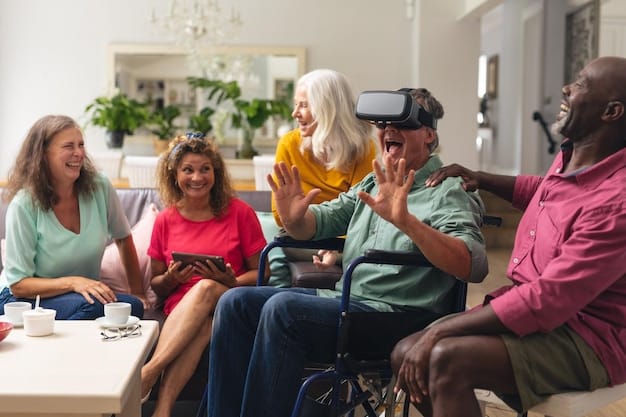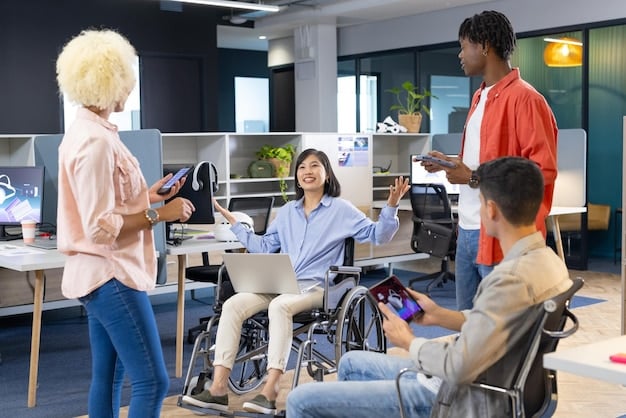How Technology Boosts Accessibility for US Disabled

Technology significantly improves accessibility for people with disabilities in the US by offering innovative solutions like assistive devices, smart home integrations, and digital tools that enhance communication, mobility, education, and employment opportunities, fostering greater independence and inclusion.
In an increasingly digitized world, the quest for inclusivity and equal opportunity for all remains paramount. For people with disabilities, embracing technological advancements has opened up unprecedented avenues for improved accessibility and independence. Exploring how technology can help improve accessibility for people with disabilities in the US means delving into a landscape of innovation, where barriers are being dismantled and potential is being unlocked, fostering a society that truly welcomes everyone.
The Power of Assistive Technology in Daily Life
Assistive technology (AT) acts as a crucial bridge, reducing the gap between individuals with disabilities and their full participation in society. These tools range from simple aids to advanced digital solutions, each designed to address specific challenges and empower users in their daily routines.
From enhancing communication to facilitating mobility, AT has transformed how people with disabilities interact with the world around them. Its development is constant, driven by both user needs and rapid technological evolution.
Enhancing Communication and Information Access
For individuals with visual or hearing impairments, accessing information and communicating effectively can be a significant hurdle. Technology has profoundly impacted these areas, creating more equitable engagement opportunities.
- Screen Readers and Magnifiers: Software like JAWS or NVDA vocalizes content on screens, while screen magnifiers enlarge text and images, offering visually impaired users independence in digital navigation.
- Closed Captioning and Transcription Services: These services provide real-time or post-production text versions of audio content, making videos, online meetings, and broadcasts accessible to individuals who are deaf or hard of hearing.
- Augmentative and Alternative Communication (AAC) Devices: From simple picture boards to sophisticated speech-generating devices, AAC tools enable non-verbal individuals to express themselves and participate in conversations.
Moreover, the integration of artificial intelligence into these tools means more natural voice synthesis, better accuracy in transcription, and more intuitive user interfaces, continually improving the user experience and effectiveness of these assistive technologies.
Revolutionizing Mobility and Navigation
Physical mobility and navigation through various environments are critical aspects of independence. Technology has introduced groundbreaking solutions that empower individuals with physical disabilities to move and explore with greater ease and safety.
Innovations in wheelchair design, particularly the advent of smart wheelchairs, incorporate features like GPS, obstacle detection, and even voice control, offering enhanced freedom. Exoskeletons are also emerging as life-changing devices, enabling individuals with paralysis to stand and walk, fundamentally altering their physical capabilities and prospects for independence.
Beyond personal devices, urban planning is beginning to leverage technology. Smart city initiatives are exploring how sensors and data can inform accessible routes, optimize public transportation for wheelchair users, and even provide real-time updates on accessible infrastructure. These advancements pave the way for more inclusive urban landscapes.
Considering the pervasive nature of technology, the continuous evolution of assistive devices promises a future where physical limitations become less of a barrier, allowing individuals to navigate their environments with unprecedented autonomy and confidence.
Smart Home Technology and Independent Living
The rise of smart home technology presents a significant opportunity to foster greater independence for people with disabilities. By automating daily tasks and providing enhanced environmental control, these systems empower individuals to manage their living spaces with increased ease and safety, reducing reliance on caregivers.
From lighting and temperature control to door locks and security systems, smart home devices can be customized to meet diverse needs, making everyday living more manageable and comfortable. This level of control contributes significantly to personal autonomy.
Automating Daily Tasks and Enhancing Safety
Smart home devices offer practical solutions for automating routine activities, thereby simplifying daily life for individuals with varying disabilities. Voice-activated assistants, for instance, can control lighting, adjust thermostats, and operate entertainment systems, minimizing the need for physical interaction with multiple devices.
- Voice Control Systems: Devices like Amazon Echo or Google Home allow users to manage appliances, set reminders, and access information using simple voice commands, benefiting individuals with limited dexterity or mobility.
- Smart Lighting and Thermostats: Automated lighting systems adapt to presence detection or voice commands, while smart thermostats learn preferences and optimize climate control, enhancing comfort and energy efficiency.
- Connected Security and Monitoring: Smart cameras, doorbells, and alarm systems can be monitored remotely via smartphones, providing peace of mind and enhancing personal safety within the home environment.
Beyond convenience, these technologies also contribute to safety. Smart smoke detectors that send alerts to mobile devices or automatically contact emergency services are particularly valuable. Furthermore, smart locks can be programmed to open for authorized caregivers without requiring physical keys, adding both security and flexibility.
Accessible Entertainment and Communication Hubs
Smart home technology extends beyond basic automation, transforming living spaces into accessible hubs for entertainment and communication. Integrating these systems can significantly enrich the social and recreational lives of individuals with disabilities.
Consider the ability to control a television, streaming services, or music players through voice commands or accessible interfaces. This eliminates the often-complex navigation of traditional remote controls, allowing for effortless leisure. Smart speakers can also act as communication aids, facilitating calls or sending messages through voice commands, breaking down barriers for those with manual dexterity challenges.
Moreover, these systems often integrate with other accessibility features, such as personalized notification settings for individuals with hearing impairments, or audio descriptions for visually impaired users, making content universally enjoyable. The potential for connectivity also allows for easier remote communication with family and friends, fostering social inclusion and reducing isolation.

Digital Accessibility and Online Inclusion
In the modern era, much of our daily lives, from banking to education to social interaction, has migrated online. For people with disabilities, digital accessibility is not merely a convenience but a fundamental requirement for full participation in society. Ensuring that websites, apps, and digital content are usable by everyone, regardless of ability, is a cornerstone of true inclusion.
Compliance with accessibility standards like WCAG (Web Content Accessibility Guidelines) is becoming increasingly important, shaping how digital products are designed and developed, moving towards a universally usable online environment.
Inclusive Website Design and User Interfaces
The foundation of digital inclusion lies in robust and thoughtful website design. An accessible website is one that can be navigated and understood by individuals using various assistive technologies and with diverse cognitive and physical abilities.
- Semantic HTML and ARIA Roles: Using proper semantic HTML tags and ARIA (Accessible Rich Internet Applications) attributes ensures that screen readers and other assistive devices can correctly interpret and convey website content and functionality.
- Keyboard Navigation: Websites must be fully navigable using only a keyboard, accommodating users who cannot use a mouse due to motor impairments. Elements should be clearly focusable and interactive.
- Color Contrast and Font Size: Sufficient color contrast between text and background, along with adjustable font sizes, is crucial for users with visual impairments or color blindness to read content comfortably.
Beyond these technical aspects, clear and concise language, intuitive navigation structures, and predictable layouts contribute significantly to a positive user experience for all, making digital content less burdensome to consume and interact with.
Accessible Learning and Employment Opportunities
Digital accessibility has profound implications for education and employment, opening doors that were previously challenging to access for people with disabilities. Online learning platforms and remote work opportunities, when designed with accessibility in mind, can revolutionize these sectors.
E-learning platforms committed to accessibility provide features such as captioned videos, downloadable transcripts, accessible document formats, and compatibility with screen readers, enabling students with diverse needs to fully engage with educational content. This flexibility allows individuals to learn at their own pace and in environments conducive to their success.
Similarly, the shift towards remote work, accelerated by recent global events, has highlighted the potential for accessible digital tools to facilitate employment for individuals with disabilities. Teleconferencing software with integrated captioning, collaborative platforms with keyboard navigation, and cloud-based applications accessible from various devices remove geographical and physical barriers to employment.
This inclusive approach to online learning and work not only benefits individuals but also enriches educational institutions and workplaces by fostering diversity and leveraging a wider pool of talent, contributing to a more equitable society.
Emerging Technologies and Future Horizons
The landscape of accessibility is continuously evolving, driven by breakthrough technologies that promise even more integrated and intuitive solutions. These emerging fields are set to further diminish barriers, creating a more inclusive future for individuals with disabilities in the US.
From artificial intelligence to virtual reality, these innovations are moving beyond simple accommodations to create genuine enhancements that could transform daily experiences and interactions.
AI, Machine Learning, and Personalized Accessibility
Artificial intelligence (AI) and machine learning (ML) are at the forefront of creating highly personalized and adaptive accessibility solutions. These technologies can learn from user behavior and preferences, providing dynamic and intelligent support.
- Predictive Text and Communication Aids: AI-powered keyboards and communication apps can predict words or phrases, speeding up communication for individuals with speech or motor impairments.
- Image Recognition for Visually Impaired: AI algorithms can describe visual content in real-time, helping visually impaired individuals understand their surroundings or interpret images on websites and social media.
- Voice Command Refinement: ML refines voice recognition, making it more accurate and adaptable to various accents and speech patterns, improving the reliability of voice-controlled devices.
The capacity of AI to process vast amounts of data allows for the development of highly nuanced assistive tools that can anticipate needs and offer proactive support, moving accessibility from a one-size-fits-all model to highly individualized experiences.
Augmented Reality (AR) and Virtual Reality (VR) for Training and Therapy
Augmented Reality (AR) and Virtual Reality (VR) are no longer confined to gaming; they hold immense potential for enhancing accessibility, particularly in therapeutic and training contexts. These immersive technologies can create safe, controlled environments for skill development and rehabilitation.
For individuals with cognitive disabilities, VR simulations can offer repeated practice in social situations, daily living skills, or job-related tasks without real-world consequences, building confidence and competence. AR applications can overlay digital information onto the real world, assisting individuals with navigation in unfamiliar places or providing real-time instructions for complex tasks.
In physical rehabilitation, AR and VR offer engaging and motivating ways to perform exercises, track progress, and provide biofeedback. This gamified approach to therapy can increase adherence and improve outcomes, making the rehabilitation process more enjoyable and effective. As these technologies become more accessible and affordable, their impact on disability services will likely grow significantly.
Policy, Advocacy, and the Digital Divide
While technological advancements provide powerful tools for improving accessibility, their full potential can only be realized through supportive policies, vigorous advocacy, and a concerted effort to bridge the digital divide. Legislation, public awareness, and equitable access to technology are fundamental to creating a truly inclusive society.
Addressing these systemic issues ensures that innovative solutions reach those who need them most and that technological progress translates into tangible improvements in the lives of people with disabilities.
Legislation and Accessibility Standards
In the US, landmark legislation such as the Americans with Disabilities Act (ADA) has been crucial in mandating accessibility in various sectors. However, the digital age presents new challenges that require continuous adaptation and enforcement of these laws.
The ADA, while initially focused on physical access, has been interpreted by courts and agencies to apply to web accessibility. Section 508 of the Rehabilitation Act further mandates that federal agencies’ electronic and information technology be accessible to people with disabilities, setting a standard for public sector entities.
Compliance with international standards like WCAG (Web Content Accessibility Guidelines) has become a benchmark for accessible digital content, promoting a consistent approach across different platforms and organizations. These guidelines cover various aspects, from text alternatives for non-text content to navigability and compatibility with assistive technologies. Rigorous enforcement and continued updates to these standards are vital to keep pace with technological evolution and ensure that no one is left behind in the digital realm.
Bridging the Digital Divide
Despite the proliferation of technology, a significant digital divide persists, particularly affecting low-income communities and individuals in rural areas, where access to high-speed internet and necessary devices can be limited. This divide disproportionately impacts people with disabilities, who rely heavily on technology for independence and participation.
- Affordable Broadband Access: Initiatives aimed at expanding affordable, high-speed internet access are critical. Programs that subsidize internet services for low-income households directly benefit individuals with disabilities who might otherwise be disconnected.
- Device and Software Access: Providing accessible devices (e.g., computers, tablets, smartphones) and specialized software at reduced costs or through public programs helps ensure that financial constraints do not limit access to empowering technologies.
- Digital Literacy Training: Offering training programs on how to use assistive technologies and navigate the digital world is essential. Many individuals may have access but lack the skills to fully leverage technological tools.
Bridging this divide requires a multi-faceted approach involving government subsidies, public-private partnerships, and community-level initiatives. Equitable access to technology is not just about connectivity; it’s about providing the full ecosystem of tools and knowledge needed to thrive in a digital society.
Challenges and Future Directions in Accessibility Tech
While the strides in assistive technology have been remarkable, significant challenges remain on the path to universal accessibility. Addressing these issues is crucial for ensuring that technological progress genuinely benefits all individuals with disabilities and that future innovations are developed with inclusivity at their core.
From the cost of advanced devices to the need for greater interoperability, overcoming these hurdles will define the next era of accessibility in the US.
Cost and Affordability of Advanced AT
One of the primary barriers to widespread adoption of advanced assistive technology is its often prohibitive cost. While some basic aids are affordable, cutting-edge devices and software, particularly those leveraging AI or advanced robotics, can be extremely expensive, placing them out of reach for many individuals and families.
Insurance coverage for AT varies significantly, and government programs often have strict eligibility criteria or limited budgets. This financial burden can prevent individuals from accessing essential tools that could dramatically improve their quality of life, independence, and employment prospects. Addressing this requires innovative financing models, expanded insurance coverage, and increased public funding for AT.
Furthermore, the rapid pace of technological change means that devices can quickly become obsolete, requiring costly upgrades or replacements. This ongoing financial commitment adds to the burden, highlighting the need for sustainable and affordable solutions in the long term.
Interoperability and Seamless Integration
Another significant challenge lies in the lack of seamless interoperability between different assistive technologies and mainstream devices or platforms. Often, devices and software from different manufacturers do not communicate effectively, creating fragmented experiences for users.
For example, a screen reader may not work optimally with a particular website, or a smart home device might not integrate well with a specific communication aid. This lack of standardization forces users to navigate complex workarounds or invest in proprietary ecosystems, limiting their choices and increasing frustration.
Greater collaboration among tech companies, adherence to open standards, and a focus on universal design principles during product development are essential to overcome this. The future of accessibility lies in an ecosystem where all devices and platforms can communicate effortlessly, providing a truly integrated and intuitive experience for individuals with disabilities.

The Role of Education and Awareness
Beyond technological development and policy implementation, broad societal education and awareness play a critical role in fostering a truly inclusive environment for people with disabilities. Technology is only as effective as its adoption and the understanding of its potential.
Educating the public, developers, and policymakers about the importance of accessibility and the capabilities of assistive technology is paramount to driving further innovation and ensuring widespread implementation.
Training for Developers and Designers
A key area where education is vital is among technology developers and designers. Many accessibility issues arise not from a lack of malicious intent, but from a lack of awareness or understanding during the design and development phases. Integrating accessibility principles from the outset, rather than as an afterthought, is far more effective and less costly.
Training programs that focus on universal design principles, WCAG guidelines, and the testing of products with actual users with disabilities can empower developers to build inclusive technologies. This includes understanding the diverse range of disabilities and how different assistive technologies interact with digital content.
By making accessibility a core competency in tech education and professional development, the industry can proactively create products and services that are inherently accessible, rather than retrofitting them later. This foundational shift is essential for a truly inclusive tech landscape.
Public Awareness and Advocacy
Public awareness campaigns and strong disability advocacy groups are indispensable in driving the conversation around accessibility and ensuring that technological advancements benefit everyone. Broad public understanding can foster empathy and support for initiatives that promote inclusion.
Advocacy groups play a crucial role in lobbying for stronger accessibility laws, holding companies accountable for compliance, and raising awareness about the needs and capabilities of people with disabilities. They also serve as vital conduits for feedback from the disability community to tech developers and policymakers, ensuring that solutions are practical and relevant.
Moreover, showcasing successful applications of assistive technology and telling the stories of individuals whose lives have been transformed by these innovations can inspire further development and greater adoption. By fostering a culture of inclusivity and emphasizing the societal benefits of accessibility, these efforts help build a future where technology truly empowers all.
| Key Area | Technological Impact |
|---|---|
| 🗣️ Communication | Screen readers, AAC devices, and captioning enhance information access and expression. |
| 🚶 Mobility | Smart wheelchairs and exoskeletons offer greater independence in movement. |
| 🏠 Independent Living | Smart home systems automate tasks, enhancing safety and control. |
| 🌐 Digital Inclusion | Accessible web design and digital tools enable equal learning and employment. |
Frequently Asked Questions About Tech & Disability Accessibility
Assistive technology (AT) refers to any item, piece of equipment, or product system that is used to increase, maintain, or improve functional capabilities of individuals with disabilities. This broad definition includes a wide range of devices, from simple communication boards to complex computer software and robotic aids, all designed to enhance participation in daily life.
Smart home technology enhances accessibility by automating various daily tasks and providing remote control over household functions. This includes voice-activated lighting, automated thermostats, smart locks, and connected security systems. These integrations reduce the need for physical dexterity or mobility, promoting greater independence and safety for individuals with disabilities in their own homes.
Digital accessibility is crucial because modern life increasingly relies on online platforms for banking, education, employment, and social interaction. Without accessible websites, apps, and digital content, people with disabilities face significant barriers to full societal participation, risking exclusion from essential services and opportunities that many take for granted in the digital age.
Artificial Intelligence (AI) plays a transformative role in accessibility by enabling more personalized and adaptive solutions. AI powers features like predictive text for communication, real-time image recognition for the visually impaired, and more accurate voice command systems. These intelligent applications can learn from user behavior, anticipate needs, and provide dynamic support, greatly enhancing the functionality of assistive technologies.
The main challenges in widespread adoption of accessible technology include the high cost of advanced devices, often prohibitive for many individuals, and the lack of seamless interoperability between different devices and platforms. Additionally, the digital divide, limiting internet and device access in underserved communities, and insufficient public awareness or training on accessibility tools also pose significant hurdles to broader implementation and integration.
Conclusion
The journey toward full accessibility for people with disabilities in the US is significantly propelled by continuous innovation in technology. From advanced assistive devices that enhance daily functioning and communication to smart home systems that foster independent living, technology is dismantling traditional barriers. Digital accessibility ensures that online spaces are inclusive, while emerging technologies like AI and AR/VR offer exciting new avenues for personalized support and immersive training. While challenges related to cost, interoperability, and the digital divide persist, sustained policy efforts, advocacy, and broad public education are vital to ensuring that these technological advancements translate into a truly equitable and inclusive society for all individuals.





